- News influencers – People who regularly post about current events and civic issues on social media and have at least 100,000 followers on any of Facebook, Instagram, TikTok, X (formerly Twitter) or YouTube.
- Political orientation – A measure of a news influencer’s partisan or ideological views. A right-leaning news influencer is one who publicly expresses that they identify as a Republican or conservative or support Donald Trump in the 2024 presidential election. A left-leaning news influencer is one who publicly expresses that they identify as a Democrat, liberal or progressive or support Vice President Kamala Harris (or supported President Joe Biden before he dropped out of the race) in the 2024 election. This information was found in the bio, profile picture, banner image, pinned posts or recent posts on an influencer’s social media account, any personal website or professional page, and prominent media coverage.
- Values and identities – Language or imagery in the bio, profile picture, banner image or pinned posts on an influencer’s social media account that expresses specific beliefs or identities.
- News organization affiliation – An influencer with this affiliation is one who either currently works for or previously worked for a news organization, as well as freelancers who have regularly contributed to news organizations. A news organization can be any news outlet that has a staff and multiple bylines. Researchers considered affiliated influencers to have this background regardless of their news organization’s political orientation, audience size or primary publishing method (digital, TV, print, etc.).
- Major social media sites – The five primary sites we studied, chosen based on audience size and the presence of discussion about news: Facebook, Instagram, TikTok, X (formerly Twitter) and YouTube.
On social media, many news consumers get news directly from journalists and news organizations, including both individual reporters and institutional feeds.
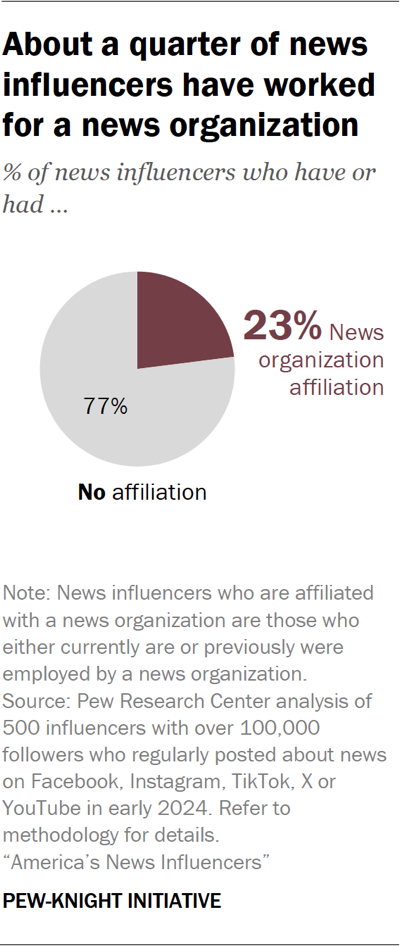
But news influencers are mostly voices from beyond the newsroom: About three-quarters (77%) have no background or affiliation with a news organization. Roughly a quarter (23%) of news influencers work for a news organization (or did so in the past).
To compare news influencers with experience producing journalism within the news industry and those who came to prominence outside of it, researchers looked for past or present affiliations with news media organizations. These groups have different career experiences and potentially different levels of formal journalistic training.
News influencers with a news organization affiliation include former CNN analyst Chris Cillizza, who now has his own Substack newsletter, as well as people with a current affiliation like Fox News host Jesse Watters and local journalists like Olivia DiVenti. Those without an affiliation have a wide variety of backgrounds, including podcaster Mike Figueredo and activist Charlie Kirk.
How we define ‘news organization affiliation’
Researchers categorized all news influencers based on whether they are currently or were previously employed by a news organization.
The list of news organizations that people in this category work for (or used to work for) is broad, ranging from long-standing newspapers to cable news channels to newer digital outlets. News organizations are defined as all outlets with a staff and multiple bylines. Researchers considered affiliated influencers to have this background regardless of their news organization’s political orientation, audience size or primary publishing method (digital, TV, print, etc.).
News influencers from the news industry are more reserved in expressing political views
There are several differences between news influencers who have worked for a news organization and those who have not.
For one, news influencers with a connection to the news industry are less likely to explicitly advertise their political orientations. About two-thirds of those who’ve worked for a news organization (64%) do not express a clear political orientation in their social media profile, posts, personal website or media coverage, compared with 44% of those without that background.
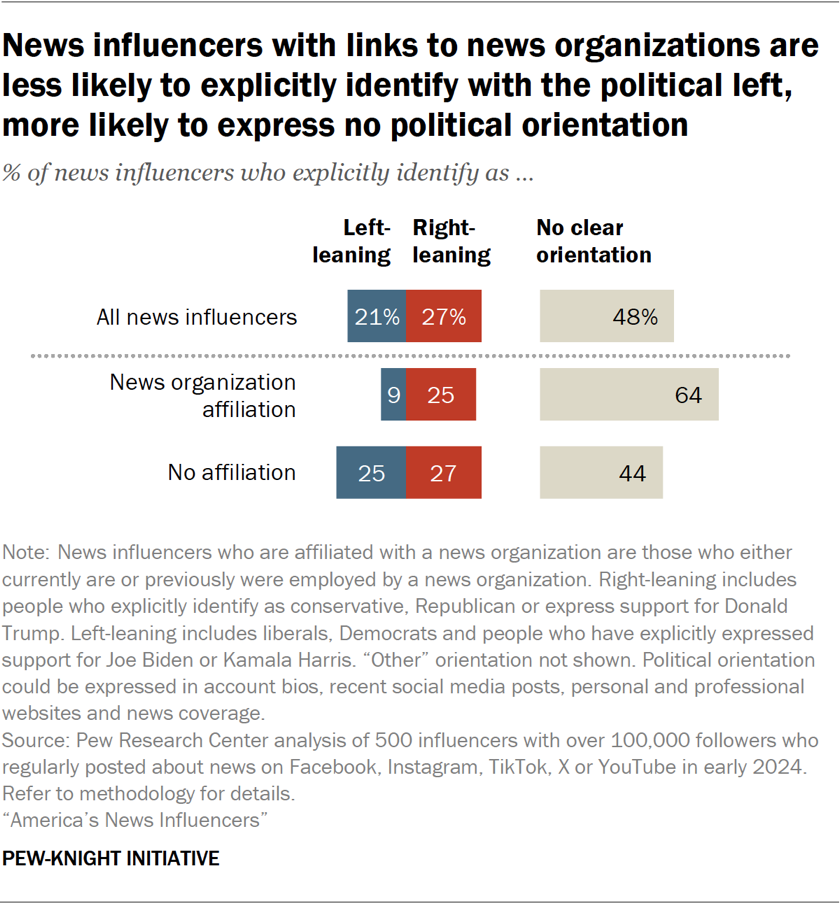
Similar shares of news influencers with and without connections to news organizations identify as right-leaning (25% and 27%, respectively). But news influencers from news organizations are less likely to explicitly identify as left-leaning.
Just 9% of news influencers with a current or former connection to a news organization say they are liberal or Democratic. Among those with no such background, 25% identify with the political left.
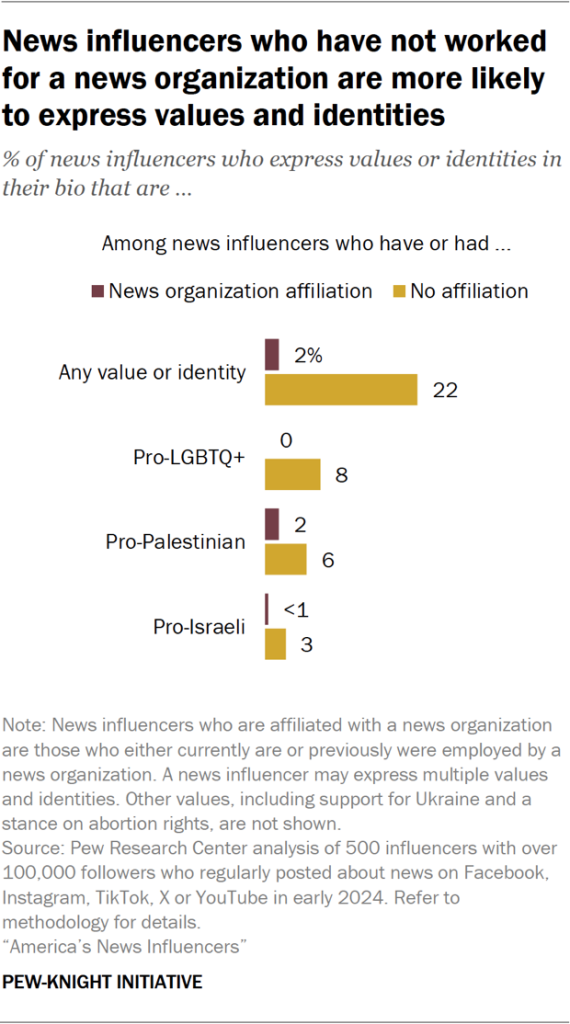
It is also much more common for news influencers without a background in the news industry to openly link themselves to certain values or identities in their social media profiles. About one-in-five influencers who have not worked for a news organization (22%) do this, compared with just 2% of those who have worked for a news organization.
In particular, news influencers not tied to the news industry are more likely to show support for LGBTQ+ rights or identify as LGBTQ+ (8%). None of those with news industry backgrounds express this appeal.
No news influencers in the sample who have worked for news organizations express a position on abortion or a pro-Ukraine stance in their accounts, while small shares of those with no affiliation with a news organization identify with these positions.
News influencers who have not worked for a news organization are more likely to be on video sites and manage fan communities
News influencers with and without links to news organizations also differ in where and how they engage with audiences.
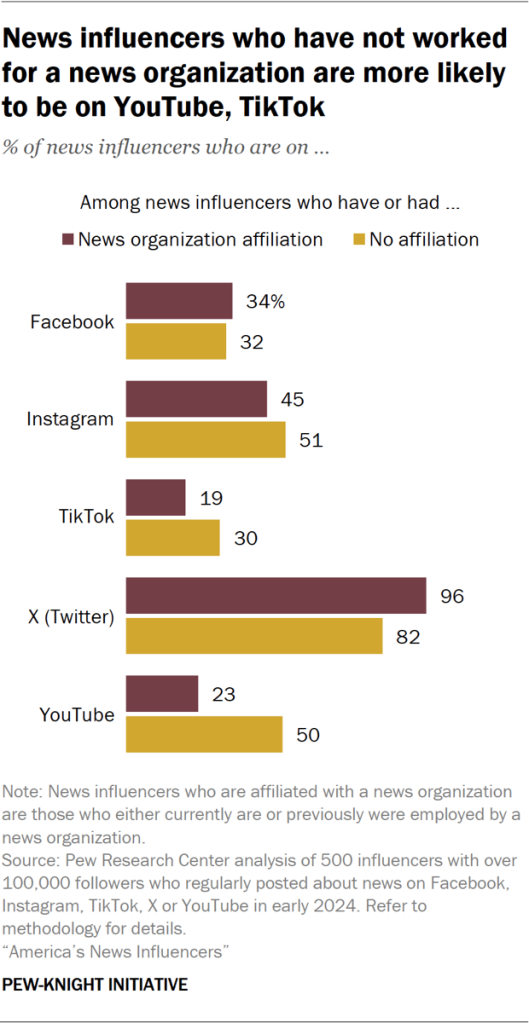
X is the most widely used social media site among all news influencers overall, but those who have been affiliated with news organizations are more likely to use the site than other news influencers (96% vs. 82%).
A previous Pew Research Center survey also indicates that the site formerly known as Twitter ranks at the top of social media sites for work-related tasks among journalists. And U.S. adults who regularly get news on X also are more likely to say they get news from journalists and news organizations than those who regularly get news on other social media sites.
By contrast, news influencers without a background in the news industry are more likely to be on YouTube and TikTok than those with that background. Half of these news influencers have a YouTube presence, roughly twice the share of their counterparts who have worked for news organizations (23%). Similarly, three-in-ten news influencers who have not worked for a news organization use TikTok, compared with just 19% of those who have links to a news outlet.
In addition to social media sites, some news influencers from outside the news industry also turn to Discord (7%) and Patreon forums (3%) to engage directly with followers. Such sites are scarcely used by those who have worked for a news organization (less than 1% each).
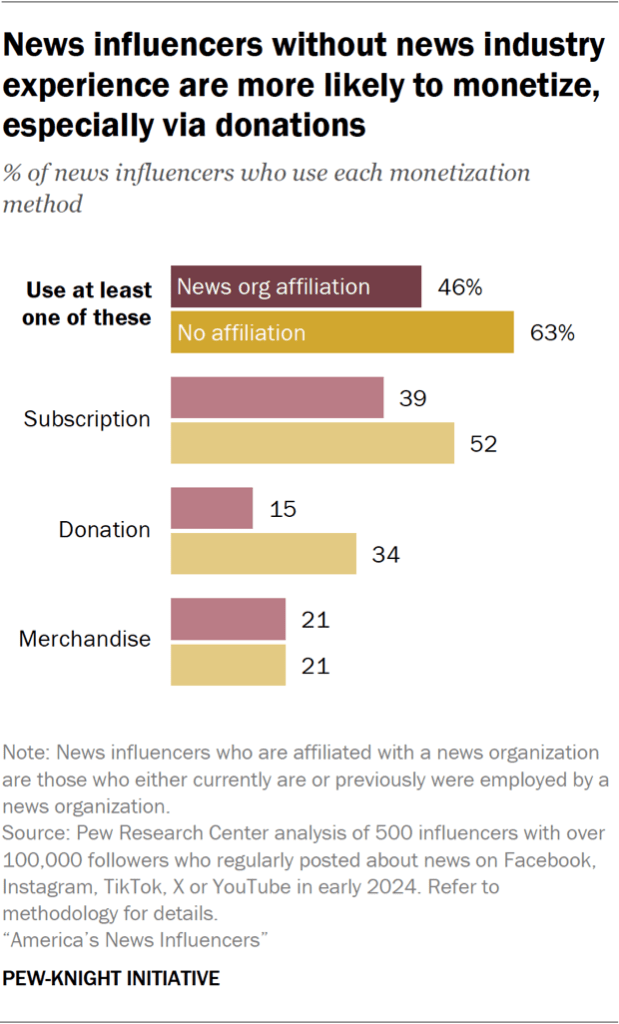
For news influencers without links to news organizations, it is also more common to make money from creating news content online. A majority of these influencers (63%) do so, compared with 46% of news influencers who have industry experience.
This includes offering subscriptions to additional content, soliciting donations and selling merchandise. In particular, news influencers who have not worked for news organizations are more inclined to solicit donations: Around a third of this group (34%) engages in this practice, compared with just 15% of those who have worked in the news industry.




